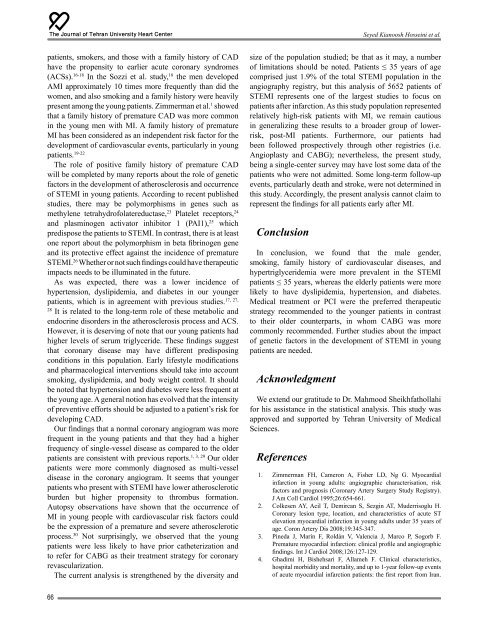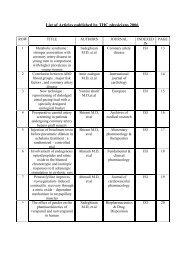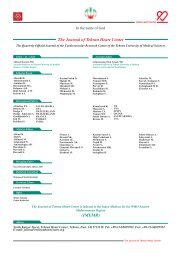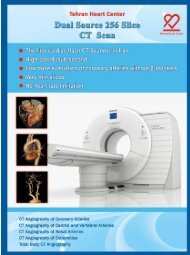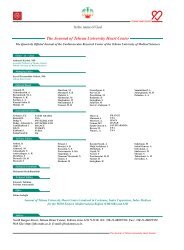Journal of Tehran University Heart Center
Journal of Tehran University Heart Center
Journal of Tehran University Heart Center
Create successful ePaper yourself
Turn your PDF publications into a flip-book with our unique Google optimized e-Paper software.
The <strong>Journal</strong> <strong>of</strong> <strong>Tehran</strong> <strong>University</strong> <strong>Heart</strong> <strong>Center</strong><br />
Seyed Kianoosh Hosseini et al.<br />
patients, smokers, and those with a family history <strong>of</strong> CAD<br />
have the propensity to earlier acute coronary syndromes<br />
(ACSs). 16-18 In the Sozzi et al. study, 18 the men developed<br />
AMI approximately 10 times more frequently than did the<br />
women, and also smoking and a family history were heavily<br />
present among the young patients. Zimmerman et al. 1 showed<br />
that a family history <strong>of</strong> premature CAD was more common<br />
in the young men with MI. A family history <strong>of</strong> premature<br />
MI has been considered as an independent risk factor for the<br />
development <strong>of</strong> cardiovascular events, particularly in young<br />
patients. 19-22<br />
The role <strong>of</strong> positive family history <strong>of</strong> premature CAD<br />
will be completed by many reports about the role <strong>of</strong> genetic<br />
factors in the development <strong>of</strong> atherosclerosis and occurrence<br />
<strong>of</strong> STEMI in young patients. According to recent published<br />
studies, there may be polymorphisms in genes such as<br />
methylene tetrahydr<strong>of</strong>olatereductase, 23 Platelet receptors, 24<br />
and plasminogen activator inhibitor 1 (PAI1), 25 which<br />
predispose the patients to STEMI. In contrast, there is at least<br />
one report about the polymorphism in beta fibrinogen gene<br />
and its protective effect against the incidence <strong>of</strong> premature<br />
STEMI. 26 Whether or not such findings could have therapeutic<br />
impacts needs to be illuminated in the future.<br />
As was expected, there was a lower incidence <strong>of</strong><br />
hypertension, dyslipidemia, and diabetes in our younger<br />
17, 27,<br />
patients, which is in agreement with previous studies.<br />
28<br />
It is related to the long-term role <strong>of</strong> these metabolic and<br />
endocrine disorders in the atherosclerosis process and ACS.<br />
However, it is deserving <strong>of</strong> note that our young patients had<br />
higher levels <strong>of</strong> serum triglyceride. These findings suggest<br />
that coronary disease may have different predisposing<br />
conditions in this population. Early lifestyle modifications<br />
and pharmacological interventions should take into account<br />
smoking, dyslipidemia, and body weight control. It should<br />
be noted that hypertension and diabetes were less frequent at<br />
the young age. A general notion has evolved that the intensity<br />
<strong>of</strong> preventive efforts should be adjusted to a patient’s risk for<br />
developing CAD.<br />
Our findings that a normal coronary angiogram was more<br />
frequent in the young patients and that they had a higher<br />
frequency <strong>of</strong> single-vessel disease as compared to the older<br />
patients are consistent with previous reports. 1, 3, 29 Our older<br />
patients were more commonly diagnosed as multi-vessel<br />
disease in the coronary angiogram. It seems that younger<br />
patients who present with STEMI have lower atherosclerotic<br />
burden but higher propensity to thrombus formation.<br />
Autopsy observations have shown that the occurrence <strong>of</strong><br />
MI in young people with cardiovascular risk factors could<br />
be the expression <strong>of</strong> a premature and severe atherosclerotic<br />
process. 30 Not surprisingly, we observed that the young<br />
patients were less likely to have prior catheterization and<br />
to refer for CABG as their treatment strategy for coronary<br />
revascularization.<br />
The current analysis is strengthened by the diversity and<br />
size <strong>of</strong> the population studied; be that as it may, a number<br />
<strong>of</strong> limitations should be noted. Patients ≤ 35 years <strong>of</strong> age<br />
comprised just 1.9% <strong>of</strong> the total STEMI population in the<br />
angiography registry, but this analysis <strong>of</strong> 5652 patients <strong>of</strong><br />
STEMI represents one <strong>of</strong> the largest studies to focus on<br />
patients after infarction. As this study population represented<br />
relatively high-risk patients with MI, we remain cautious<br />
in generalizing these results to a broader group <strong>of</strong> lowerrisk,<br />
post-MI patients. Furthermore, our patients had<br />
been followed prospectively through other registries (i.e.<br />
Angioplasty and CABG); nevertheless, the present study,<br />
being a single-center survey may have lost some data <strong>of</strong> the<br />
patients who were not admitted. Some long-term follow-up<br />
events, particularly death and stroke, were not determined in<br />
this study. Accordingly, the present analysis cannot claim to<br />
represent the findings for all patients early after MI.<br />
Conclusion<br />
In conclusion, we found that the male gender,<br />
smoking, family history <strong>of</strong> cardiovascular diseases, and<br />
hypertriglyceridemia were more prevalent in the STEMI<br />
patients ≤ 35 years, whereas the elderly patients were more<br />
likely to have dyslipidemia, hypertension, and diabetes.<br />
Medical treatment or PCI were the preferred therapeutic<br />
strategy recommended to the younger patients in contrast<br />
to their older counterparts, in whom CABG was more<br />
commonly recommended. Further studies about the impact<br />
<strong>of</strong> genetic factors in the development <strong>of</strong> STEMI in young<br />
patients are needed.<br />
Acknowledgment<br />
We extend our gratitude to Dr. Mahmood Sheikhfathollahi<br />
for his assistance in the statistical analysis. This study was<br />
approved and supported by <strong>Tehran</strong> <strong>University</strong> <strong>of</strong> Medical<br />
Sciences.<br />
References<br />
1. Zimmerman FH, Cameron A, Fisher LD, Ng G. Myocardial<br />
infarction in young adults: angiographic characterisation, risk<br />
factors and prognosis (Coronary Artery Surgery Study Registry).<br />
J Am Coll Cardiol 1995;26:654-661.<br />
2. Colkesen AY, Acil T, Demircan S, Sezgin AT, Muderrisoglu H.<br />
Coronary lesion type, location, and characteristics <strong>of</strong> acute ST<br />
elevation myocardial infarction in young adults under 35 years <strong>of</strong><br />
age. Coron Artery Dis 2008;19:345-347.<br />
3. Pineda J, Marín F, Roldán V, Valencia J, Marco P, Sogorb F.<br />
Premature myocardial infarction: clinical pr<strong>of</strong>ile and angiographic<br />
findings. Int J Cardiol 2008;126:127-129.<br />
4. Ghadimi H, Bishehsari F, Allameh F. Clinical characteristics,<br />
hospital morbidity and mortality, and up to 1-year follow-up events<br />
<strong>of</strong> acute myocardial infarction patients: the first report from Iran.<br />
66


